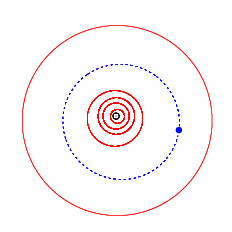 Orbit of Gaussia (blue) compared to those of the inner planets and Jupiter (outermost) | |
| Discovery[1] | |
|---|---|
| Discovered by | S. Belyavskyj |
| Discovery site | Simeiz Obs. |
| Discovery date | 8 August 1923 |
| Designations | |
| (1001) Gaussia | |
| Pronunciation | /ˈɡaʊsiə/[2] |
Named after | Carl Friedrich Gauss (German mathematician)[3] |
| 1923 OA · A907 XC A911 MD | |
| main-belt · (outer)[1][4] | |
| Orbital characteristics[1] | |
| Epoch 4 September 2017 (JD 2458000.5) | |
| Uncertainty parameter 0 | |
| Observation arc | 109.33 yr (39,933 days) |
| Aphelion | 3.6150 AU |
| Perihelion | 2.8046 AU |
| 3.2098 AU | |
| Eccentricity | 0.1262 |
| 5.75 yr (2,100 days) | |
| 121.11° | |
| 0° 10m 17.04s / day | |
| Inclination | 9.2958° |
| 259.32° | |
| 142.51° | |
| Physical characteristics | |
| Dimensions | 67.80±19.69 km[5] 68.51±21.78 km[6] 72.422±1.517 km[7] 72.711±0.298 km[8] 74.67±3.8 km[9] 74.71 km (derived)[4] 75.40±0.99 km[10] 80.07±0.68 km[11] |
| 4.08±0.05 h[12] 9.17±0.01 h[13] 20.99±0.01 h[a] | |
| 0.036±0.007[11] 0.039±0.001[10] 0.0392±0.004[9] 0.041±0.004[8] 0.0416±0.0054[7] 0.0417 (derived)[4] 0.05±0.03[5] 0.05±0.04[6] | |
| Tholen = PC[1][4] B–V = 0.689[1] U–B = 0.265[1] | |
| 9.70[4][5][11] · 9.72[6] · 9.77[7][9][10] · 9.8[1] · 9.91±0.26[14] | |
Gaussia (minor planet designation: 1001 Gaussia), provisional designation 1923 OA, is a dark background asteroid from the outer regions of the asteroid belt, approximately 73 kilometers in diameter. It was discovered on 8 August 1923, by Soviet astronomer Sergey Belyavsky at the Simeiz Observatory on the Crimean peninsula.[15] The asteroid was named after German mathematician Carl Friedrich Gauss.[3] Gauss computed the orbit of Ceres, and 1001 Gaussia was named along with 1000 Piazzia, and 1002 Olbersia in part for their work on Ceres, with names for Giuseppe Piazzi, who found Ceres, and Heinrich Wilhelm Matthias Olbers, who recovered it later that year.[16]
- ^ a b c d e f g Cite error: The named reference
jpldatawas invoked but never defined (see the help page). - ^ "Gaussian". Oxford English Dictionary (Online ed.). Oxford University Press. (Subscription or participating institution membership required.)
- ^ a b Cite error: The named reference
springerwas invoked but never defined (see the help page). - ^ a b c d e Cite error: The named reference
lcdbwas invoked but never defined (see the help page). - ^ a b c Cite error: The named reference
Nugent-2015was invoked but never defined (see the help page). - ^ a b c Cite error: The named reference
Nugent-2016was invoked but never defined (see the help page). - ^ a b c Cite error: The named reference
WISEwas invoked but never defined (see the help page). - ^ a b Cite error: The named reference
Masiero-2014was invoked but never defined (see the help page). - ^ a b c Cite error: The named reference
SIMPSwas invoked but never defined (see the help page). - ^ a b c Cite error: The named reference
AKARIwas invoked but never defined (see the help page). - ^ a b c Cite error: The named reference
Masiero-2012was invoked but never defined (see the help page). - ^ Cite error: The named reference
geneva-obswas invoked but never defined (see the help page). - ^ Cite error: The named reference
Bonzo-2010was invoked but never defined (see the help page). - ^ Cite error: The named reference
Veres-2015was invoked but never defined (see the help page). - ^ Cite error: The named reference
MPC-objectwas invoked but never defined (see the help page). - ^ Nicholson, S. B. (1941). "1941ASPL....3..365N Page 365". Leaflet of the Astronomical Society of the Pacific. 3 (147): 365. Bibcode:1941ASPL....3..365N.
Cite error: There are <ref group=lower-alpha> tags or {{efn}} templates on this page, but the references will not show without a {{reflist|group=lower-alpha}} template or {{notelist}} template (see the help page).